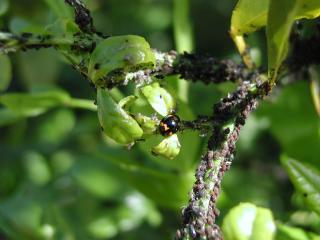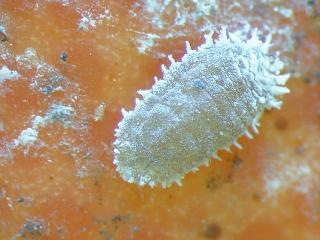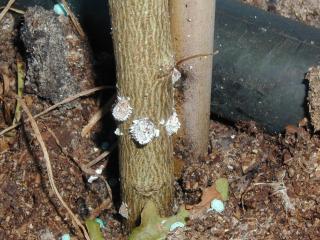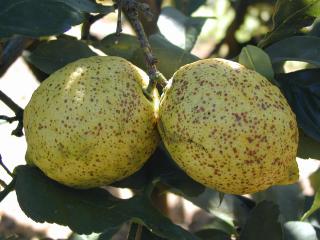Aphids, mealybugs and scales appear on plant parts in clusters and feed on the sweet sap by inserting a needle-like sucking tube into the plant and drawing out the juice. After the sap has been used by the insects, it is excreted as honeydew, which forms the base on which a black fungus grows. This fungus is known as sooty mould and its presence reduces photosynthesis and discolours affected fruit.
Honeydew is used as a food source by ants, which actively transport the insects (aphids, mealybugs and scales) and position them on the plant.
Ants may spread sapsucker infestations between plants via underground tunnels.
As aphids, mealybugs and scales congregate in hidden places, or on the lower leaf surface, they may initially not be obvious. Affected plants appear water-stressed and leaves turn yellow and fall. In some cases leaves and flowers curl up and wilt.
Aphids, mealybugs and scales all have the potential to transmit viruses between plants. However, aphids are the most likely transmitters.
Aphids
Most aphids are soft bodied, pear-shaped insects, 1-2mm long, which prefer feeding on tender growing shoots. In Western Australia, most aphids are females which are able to give birth to living young without the need to mate. Reproduction is fast when weather conditions are favourable, leading to a rapid build-up and aphid population outbreaks. Cold conditions slow their rate of development and movement. Normally, the whole family will be found feeding together.
The young aphids (nymphs) go through several growth stages, moulting at each stage. Nymphs do not have wings. When conditions are favourable and aphids have no reason to migrate, most adults will be wingless.
However, when plants become unsuitable habitats, or when overcrowding occurs, winged aphids develop and migrate to other plants or crops.
Winged aphids may originate in weeds or neglected garden plants in the neighbourhood. They are less likely to come from strong, healthy plants. Even when disturbed, aphids move quite slowly.
There are many aphid species and they attack just about every type of plant. They also come in many colours. All aphids feed by sucking on plant juices and they may transmit plant diseases at the same time. The leaf distortions so often seen with aphids are mostly caused by transmitted viruses. Aphids are most active in spring and autumn.
Control
Aphid infestations, which originate from nearby, can be prevented by removal of host weeds and neglected, stressed plants, and by keeping target plants well watered, fertilised and healthy.
Encouraging beneficial organisms which attack aphids, such as ladybirds, hoverflies, parasitic wasps and lacewings, will help to keep aphids to a minimum. Beneficial organisms can be supported/encouraged by using minimal amounts of broad spectrum pesticides.
Aphids can be removed from plants with a jet of water, squashed with finger and thumb or sprayed with organic garlic and chilli sprays.
Sprays with horticultural soap will desicate and suffocate the insects and horticultural oil will smother the insects but these organic products should not be used when the weather is above 32°C as plant leaves can burn. Alternative products are the low toxicity, residual chemicals imidacloprid and acetamiprid.
Mealybugs
Mealybugs are about 3-7mm long and cause similar damage to aphids — distorted leaves, weakened plants covered with shiny honeydew, and sooty mould. Mealybugs are covered in a whitish ‘mealy’ wax, which helps retard the loss of water from their soft bodies. They generally prefer warm, humid, sheltered sites away from harsh environmental conditions and natural enemies.
Different species of mealybugs prefer different feeding sites. Some species feed in and under bark, some on the roots of pot plants while others feed on fruits, flowers or seed heads. The adults are slow-moving insects.
Mealybug populations can build up quickly. Similar to aphids, they feed by inserting their straw-like mouthparts into plant tissue. Feeding damage can be by direct removal of plant fluids and nutrients, and/or by the excretion of toxic salivary compounds into plant tissue.
Australia has several mealybugs which are worldwide pests, the worst being the long-tailed mealybug (Pseudococcus longispinus) which is present in Western Australia and the Citrophilous mealybug (Pseudococcus calceolariae), not yet identified in WA.
Most mealybugs have a number of often overlapping generations per year. Their development is dependent on temperature. Temperatures of about 25°C and a high relative humidity are optimum for mealybugs and, like aphids, their populations reach peaks in spring and autumn.
Eggs can be laid singly or in clusters, and female long-tailed mealybugs have been recorded laying as many as 200 eggs in a lifetime. Egg clusters are usually embedded in a cocoon of waxy filaments.
After hatching, the juveniles (crawlers) search for suitable feeding sites in sheltered areas. Crawlers can be dispersed by wind and progress through five moults before reaching adulthood. For males, the last juvenile stage pupates in a silk cocoon, and emerges as a winged adult. Adult males do not feed, having no mouthparts — their sole purpose is to mate with females.
Control
Because mealybugs have high reproductive capacities and multiple generations in a year, they have the potential to become resistant to pesticides very quickly. Fortunately mealybugs can be controlled using ‘soft’ methods including biological agents and low-toxicity pesticides, most of which are readily available to the home gardener.
Good control of mealybugs can be achieved by releasing parasitic wasps such as Leptomastix dactylopii and Anagyrus fusciventris into the infested area. The wasps lay their eggs into young mealybugs: on hatching, the wasp larvae feed on the internal fluids of the mealybugs. The mealybugs are usually killed when the wasp larvae pupate.
Predatory ladybird beetles also attack many species of mealybugs, including the long-tailed mealybug, although they don't match the effectiveness of the parasitic wasps in terms of control.
Predatory insects (and mites) are sold by a number of Australian companies. For your nearest supplier refer to the Australasian Biological Control Association.
Sprays with horticultural soap will desicate and suffocate the insects and horticultural oil will smother the insects but these organic products should not be used when the weather is above 32°C as plant leaves can burn. Alternative products are the low toxicity, residual chemicals imidacloprid and acetamiprid.
Scales
Scale insects vary greatly in size but are usually about 1-5mm long. They are mainly pests of indoor plants, hedges and of orchards. Like aphids and mealybugs, they are sapsuckers, producing honeydew and sooty mould. Severe infestations of scale insects can result in defoliation and retardation of the plant’s growth, and even in the death of the plant.
Scale insects mostly have a waxy or armoured cover which they use to protect themselves. There are two categories of scales — ‘soft’ and ‘armoured’ — and they can take various shapes. Most soft scales belong to the Coccidae while the armoured scales belong to the Diaspididae. In Australia, citrus red scale is probably the most important of the scale insects considered to be pests. Damage by this scale insect can result in severe downgrading of fruit quality. ‘Damage’ is due to marking of the fruit by the scales themselves and/or marking of the fruit by sooty mould growing on scale insect honeydew. Large infestations of citrus red scale can result in severe weakening of citrus trees, with resulting loss in yield. In particularly bad cases, the citrus trees can die.
There are hundreds of species of scale insects in Australia. They attack a wide range of host plants including ferns, conifers and flowering plants and some of the soft scales infest hedges, where the dense foliage makes them hard to control.
In soft scales, some scale insects hatch from eggs, while others are born live. Juvenile scales are known as crawlers. They disperse to favourable sites on the leaf, settle down and start feeding. The juveniles then become sedentary and start building their protective scale covers.
The females of most species remain under the covers for their entire life, while the male insects live under the covers until maturity, when they emerge as winged adults. Females are generally headless, legless and wingless, and when mature, they produce eggs, then die. Most species of scale insects lay their eggs externally beneath the scale, although some species form a cyst with their egg mass within their bodies. A female scale insect can lay more than 150 eggs in its reproductive phase. Fertilisation is not necessary in some species of soft scale insects. For some of these species, no males have been recorded.
Control
For a domestic situation, removal and disposal of infected plant material may be effective. For minor infestations scale insects can be rubbed off using a damp cloth. Sprays with horticultural soap will desicate and suffocate the insects and horticultural oil will smother the insects but these low toxicity products should not be used when the weather is above 32°C as plant leaves can burn. Alternative products are the low toxicity, residual chemicals imidacloprid and acetamiprid.
The parasitic wasps Aphytis melinus, Aphytis lingnanensis, and Comperiella spp. are used in Australia in many integrated pest management programs to control armoured scale insects. The scale-eating ladybird (Rhyzobius lophanthae) is also used to control scales, especially citrus red scale.;">
Waxy scale insects are much harder to control with either biological or chemical agents than armoured scale insects.
Biosecurity awareness
The Department of Primary Industries and Regional Development is involved in passive surveillance of many exotic pests including the striped mealybug (Ferissia virgata) and Citrophilous mealybug (Pseudococcus calceolariae). These are two of more than 30 species of pest scales which are found elsewhere in Australia but are not present in Western Australia.
Unfamiliar pests could cause significant problems for our primary industries and environment if they were to become established in Western Australia.
If you see an unfamilar pest please contact the Pest and Disease Information Service (PaDIS) on 9368 3080 or padis@dpird.wa.gov.au .





